A Preliminary Study of Three-Point Onboard External Calibration for Tracking Radiometric Stability and Accuracy
Abstract
:1. Introduction
2. Linear Onboard Radiometer Calibration
3. Two-Point Calibration
4. Three-Point Calibration
4.1. Measurement Data Processing Path
4.2. Calibration Validation Data Processing Path
5. Analysis
5.1. Effect of the Measurand Temperature
5.2. Choice of Calibration Temperatures
5.3. Effect of the Integration Time
6. Sample Study
6.1. MIR Calibration Experiment
6.2. Temporal Stability of MIR
6.3. MIR Calibration Drifts
7. Conclusions
Author Contributions
Funding
Acknowledgments
Conflicts of Interest
References
- Ohring, G.; Wielicki, B.; Spencer, R.; Emery, B.; Datla, R. Satellite Instrument Calibration for Measuring Global Climate Change. Report of a Workshop. Bull. Am. Meteorol. Soc. 2005, 86, 1303–1314. [Google Scholar] [CrossRef]
- Guenther, B.; Butler, J.; Ardanuy, P. Workshop on strategies for calibration and validation of global change measurements. NASA Ref. Publ. 1997, 1397, 125. [Google Scholar]
- Ruf, C.S. Detection of calibration drifts in spaceborne microwave radiometers using a vicarious cold reference. IEEE Trans. Geosci. Remote Sens. 2000, 38, 44–52. [Google Scholar] [CrossRef]
- Draper, D.W.; Newell, D.A.; Wentz, F.J.; Krimchansky, S.; Skofronick-Jackson, G.M. The global precipitation measurement (GPM) microwave imager (GMI): Instrument overview and early on-orbit performance. IEEE J. Sel. Top. Appl. Earth Obs. Remote Sens. 2015, 8, 3452–3462. [Google Scholar] [CrossRef]
- Njoku, E.; Stacey, J.M.; Barath, F.T. The Seasat scanning microwave radiometer (SMMR): Instrument description and performance. IEEE J. Oceanic Eng. 1980, 5, 100–115. [Google Scholar] [CrossRef]
- Hollinger, J.P.; Pierce, J.L.; Poe, G.A. SSM/I instrument evaluation. IEEE Trans. Geosci. Remote Sens. 1990, 28, 781–790. [Google Scholar] [CrossRef]
- Ruf, C.S.; Keihm, S.J.; Janssen, M.A. TOPEX/POSEIDON microwave radiometer (TMR)—I: Instrument description and antenna temperature calibration. IEEE Trans. Geosci. Remote Sens. 1995, 33, 125–137. [Google Scholar] [CrossRef]
- Wilson, W.J.; Tanner, A.B.; Pellerano, F.A.; Horgan, K.A. Ultra Stable Microwave Radiometers for Future Sea Surface Salinity Missions; Jet Propulsion Laboratory, National Aeronautics and Space Administration: Pasadena, CA, USA, 2005.
- Racette, P.; Lang, R.H. Radiometer design analysis based upon measurement uncertainty. Radio Sci. 2005, 40, 1–22. [Google Scholar] [CrossRef]
- Draper, D.W.; Newell, D.A.; McKague, D.S.; Piepmeier, J.R. Assessing calibration stability using the Global Precipitation Measurement (GPM) Microwave Imager (GMI) noise diodes. IEEE J. Sel. Top. Appl. Earth Obs. Remote Sens. 2015, 8, 4239–4247. [Google Scholar] [CrossRef]
- Weissbrodt, E. Active Electronic loads for Radiometric Calibration. Ph.D. Thesis, University of Stuttgart, Stuttgart, Germany, 2017. [Google Scholar] [CrossRef]
- Fernandez, S.; Murk, A.; Kämpfer, N. Design and characterization of a Peltier-cold calibration target for a 110-GHz radiometer. IEEE Trans. Geosci. Remote Sens. 2015, 53, 344–351. [Google Scholar] [CrossRef]
- Jewell, P. Millimeter Wave Calibration; Single Dish Summer School, National Radio Astronomy Observatory: Green Bank, WV, USA, 2003. [Google Scholar]
- Murk, A.; Reveles, J.R.; Wylde, R.; Bell, G.; Zivkovic, I.; McNamara, A.; de Maagt, P. Low mass calibration target for MM-wave remote sensing instruments. IEEE Trans. Antennas Propag. 2013, 61, 1547–1556. [Google Scholar] [CrossRef]
- Houtz, D.A. NIST Microwave Blackbody: The Design, Testing, and Verification of a Conical Brightness Temperature Source. Ph.D. Thesis, University of Colorado, Boulder, CO, USA, 2017. [Google Scholar]
- Draper, N.R.; Smith, H. Applied Regression Analysis, 3rd ed.; John Wiley: Hoboken, NJ, USA, 1998. [Google Scholar]
- Aksoy, M.; Racette, P.E. Tracking Radiometer Calibration Stability Using Three-Point Onboard Calibration. In Proceedings of the 2018 IEEE 15th Specialist Meeting on Microwave Radiometry and Remote Sensing of the Environment (MicroRad), Cambridge, MA, USA, 27–30 March 2018; pp. 1–4. [Google Scholar] [CrossRef]
- Aksoy, M.; Racette, P.E. Tracking calibration stability in climate monitoring microwave radiometers using onboard 3-point calibration. In Proceedings of the 2017 IEEE International Geoscience and Remote Sensing Symposium (IGARSS), Fort Worth, TX, USA, 23–28 July 2017; pp. 2118–2120. [Google Scholar] [CrossRef]
- Racette, P.E. Application of Ensemble Detection and Analysis to modeling uncertainty in non stationary processes. In Proceedings of the 2010 IEEE International Geoscience and Remote Sensing Symposium (IGARSS), Honolulu, HI, USA, 25–30 July 2010; pp. 582–585. [Google Scholar] [CrossRef]
- Racette, P.E.; Adler, R.F.; Wang, J.R.; Gasiewski, A.J.; Zacharias, D.S. An airborne millimeter-wave imaging radiometer for cloud, precipitation, and atmospheric water vapor studies. J. Atmos. Oceanic Technol. 1996, 13, 610–619. [Google Scholar] [CrossRef]
- Racette, P.E. Radiometer Design Analysis Based on Measurement Uncertainty. Ph.D. Thesis, George Washington University, Washington, DC, USA, 2005. [Google Scholar]
- Racette, P.E.; Wang, J.; Evans, P.; Saunders, R.; Gasiewski, A.; Jackson, D. A calibration experiment using the millimeter-wave imaging radiometer at the UK Meteorological Office calibration facility. In Proceedings of the 1995 International Geoscience and Remote Sensing Symposium (IGARSS): Quantitative Remote Sensing for Science and Applications, Firenze, Italy, 10–14 July 1995; pp. 809–811. [Google Scholar] [CrossRef]
- Saunders, R.W.; Hewison, T.J.; Stringer, S.J.; Atkinson, N.C. The radiometric characterization of AMSU-B. IEEE Trans. Microw. Theory Tech. 1995, 43, 760–771. [Google Scholar] [CrossRef]
- Brown, S.T.; Desai, S.; Lu, W.; Tanner, A. On the Long-Term Stability of Microwave Radiometers Using Noise Diodes for Calibration. IEEE Trans. Geosci. Remote Sens. 2007, 45, 1908–1920. [Google Scholar] [CrossRef]
- Draper, D.W.; Newell, D.A. Global Precipitation Measurement (GPM) Microwave Imager (GMI) calibration features and predicted performance. In Proceedings of the 2010 IEEE 11th Specialist Meeting on Microwave Radiometry and Remote Sensing of the Environement, Washington, DC, USA, 1–4 March 2010; pp. 236–240. [Google Scholar] [CrossRef]
- Blackwell, W.J.; Barrett, J.W.; Chen, F.W.; Leslie, R.V.; Rosenkranz, P.W.; Schwartz, M.J.; Staelin, D.H. NPOESS Aircraft Sounder Testbed-Microwave (NAST-M): Instrument description and initial flight result. IEEE Trans. Geosci. Remote Sens. 2001, 39, 2444–2453. [Google Scholar] [CrossRef]

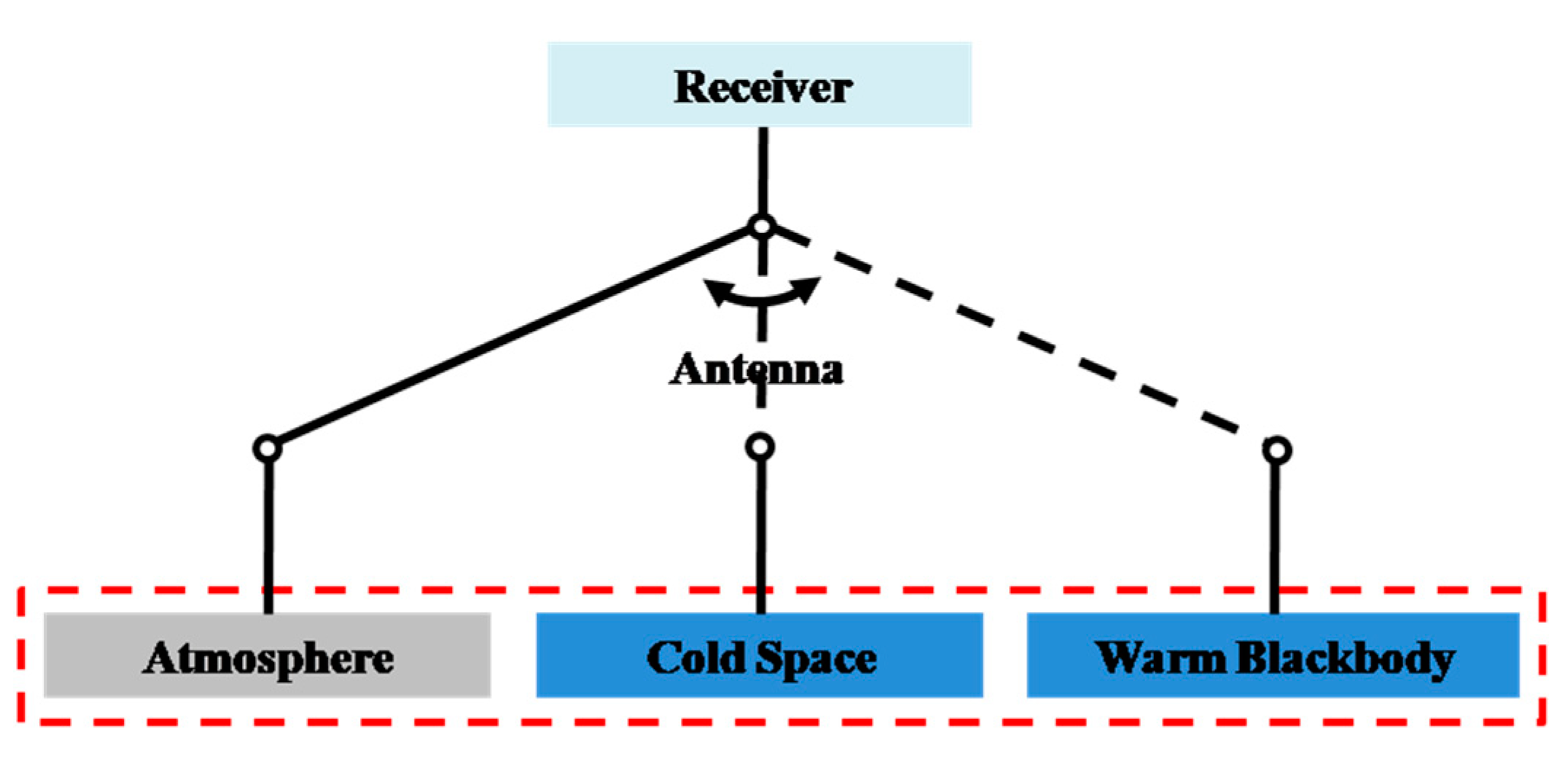





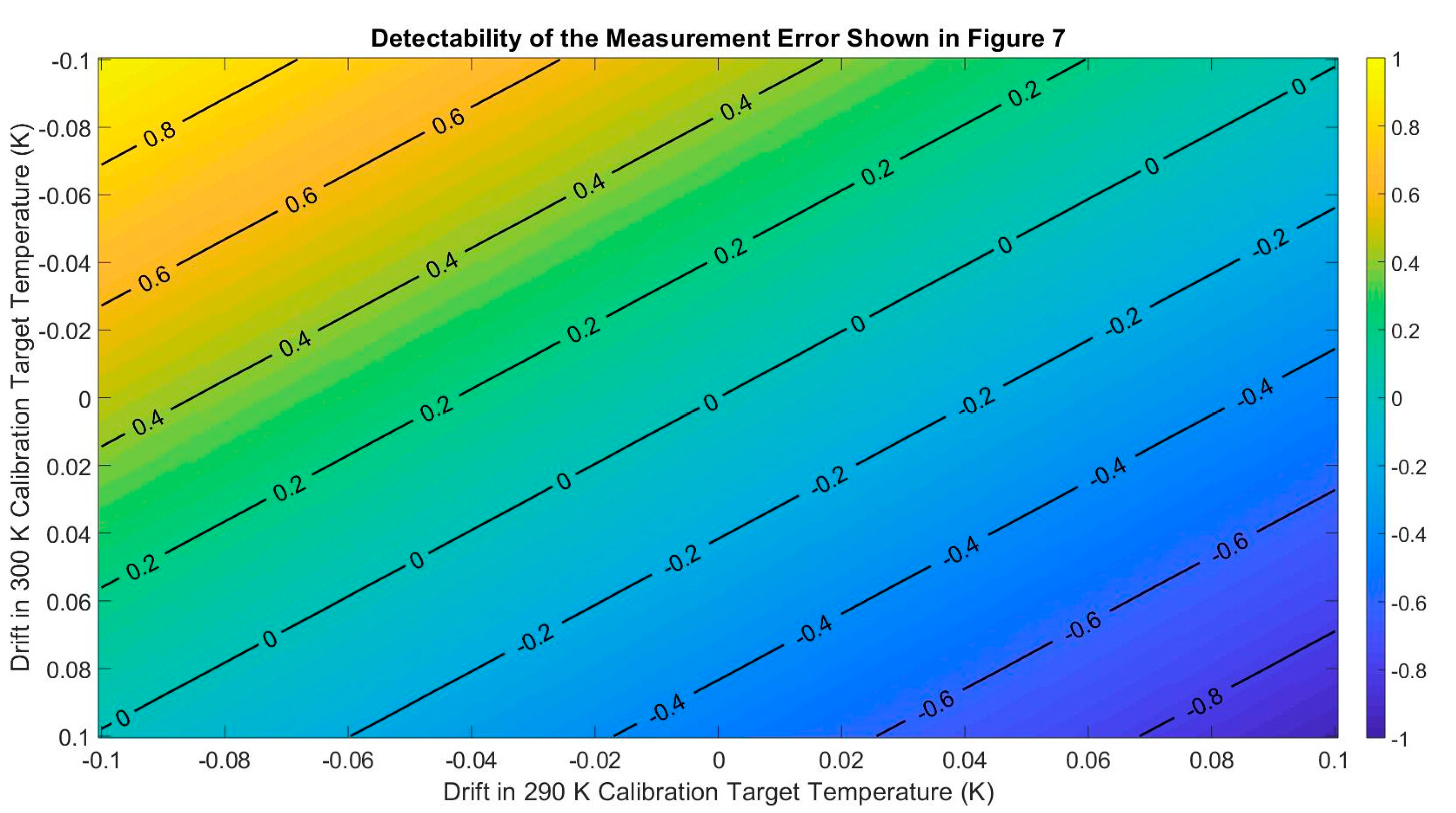


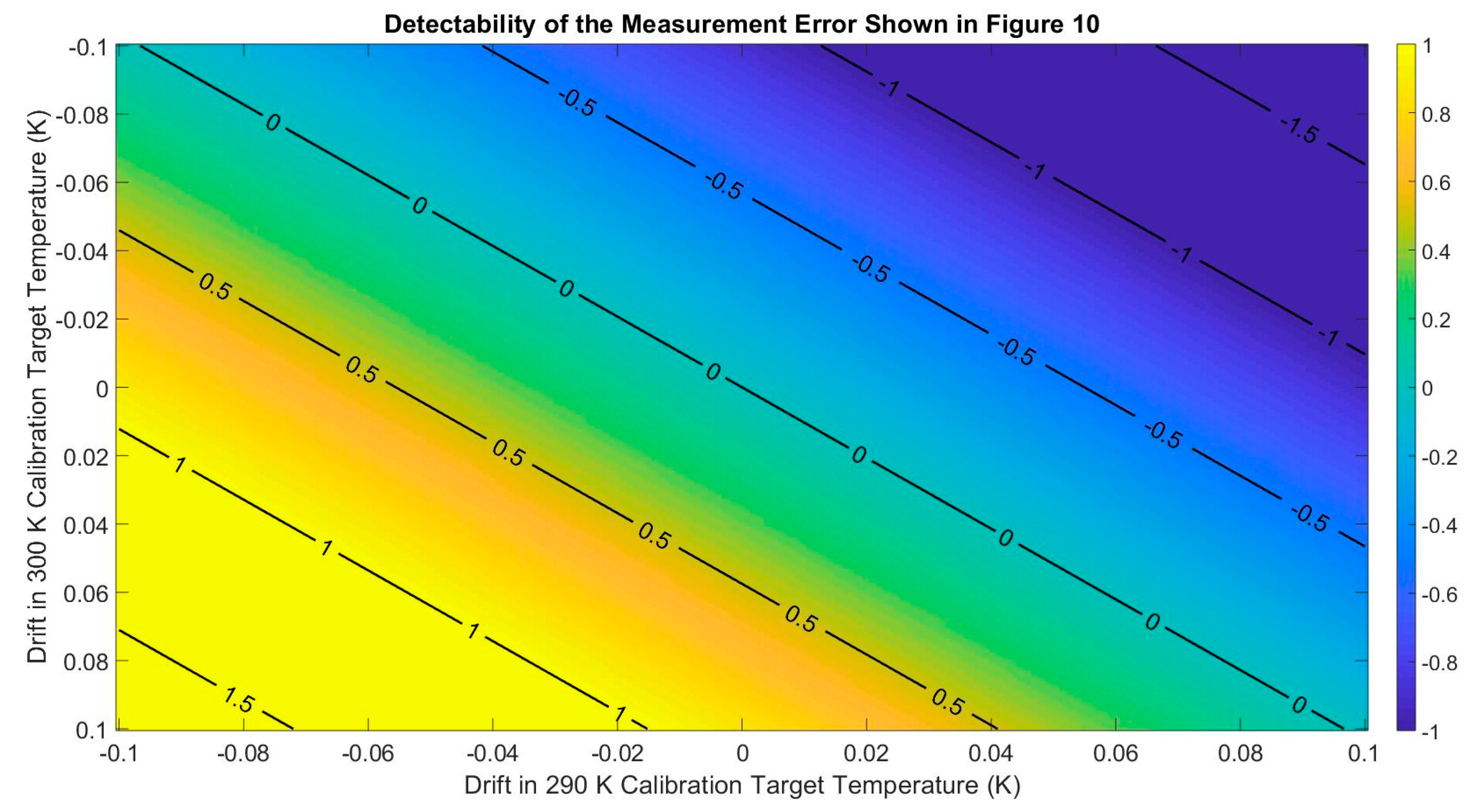

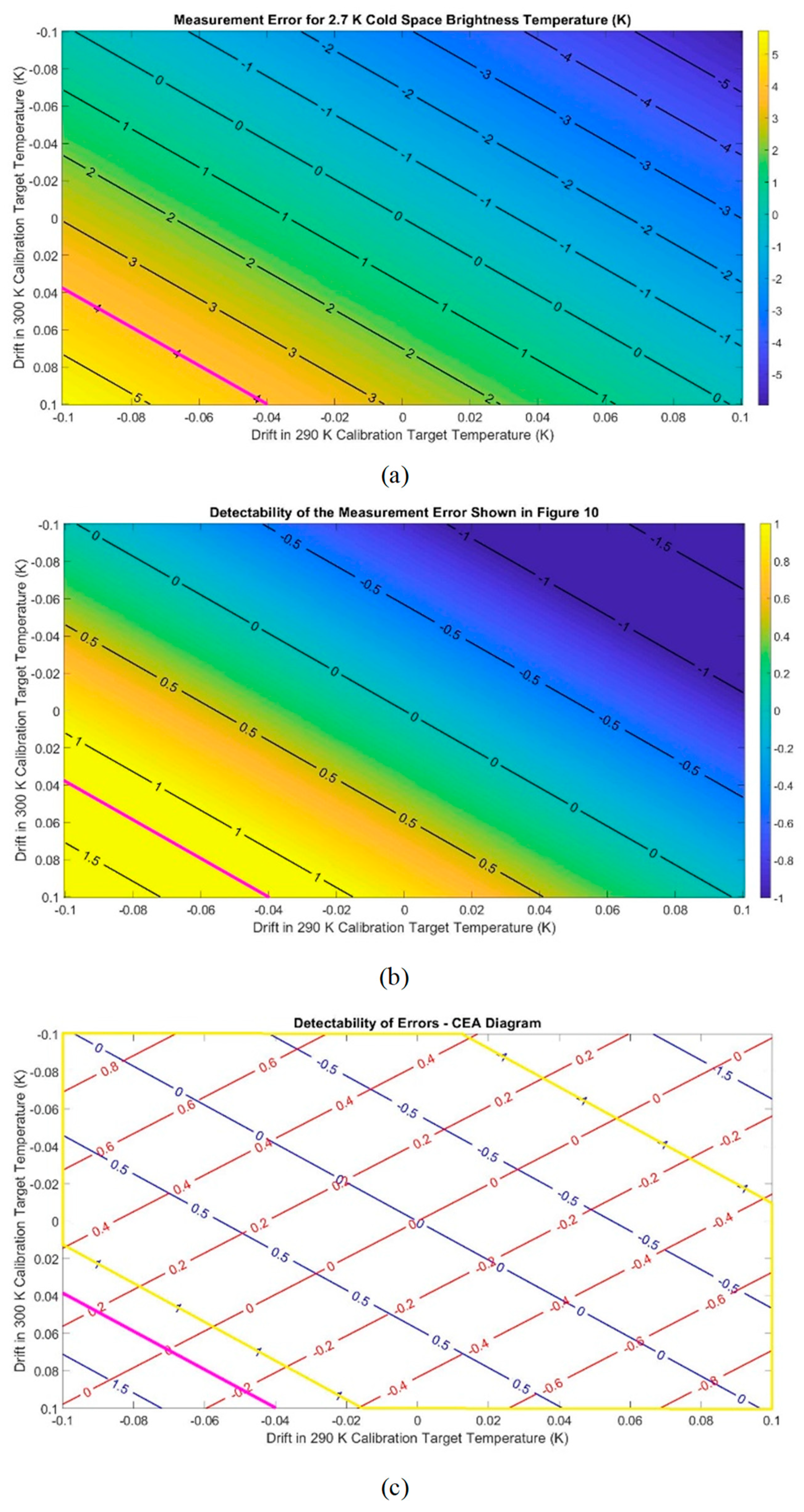




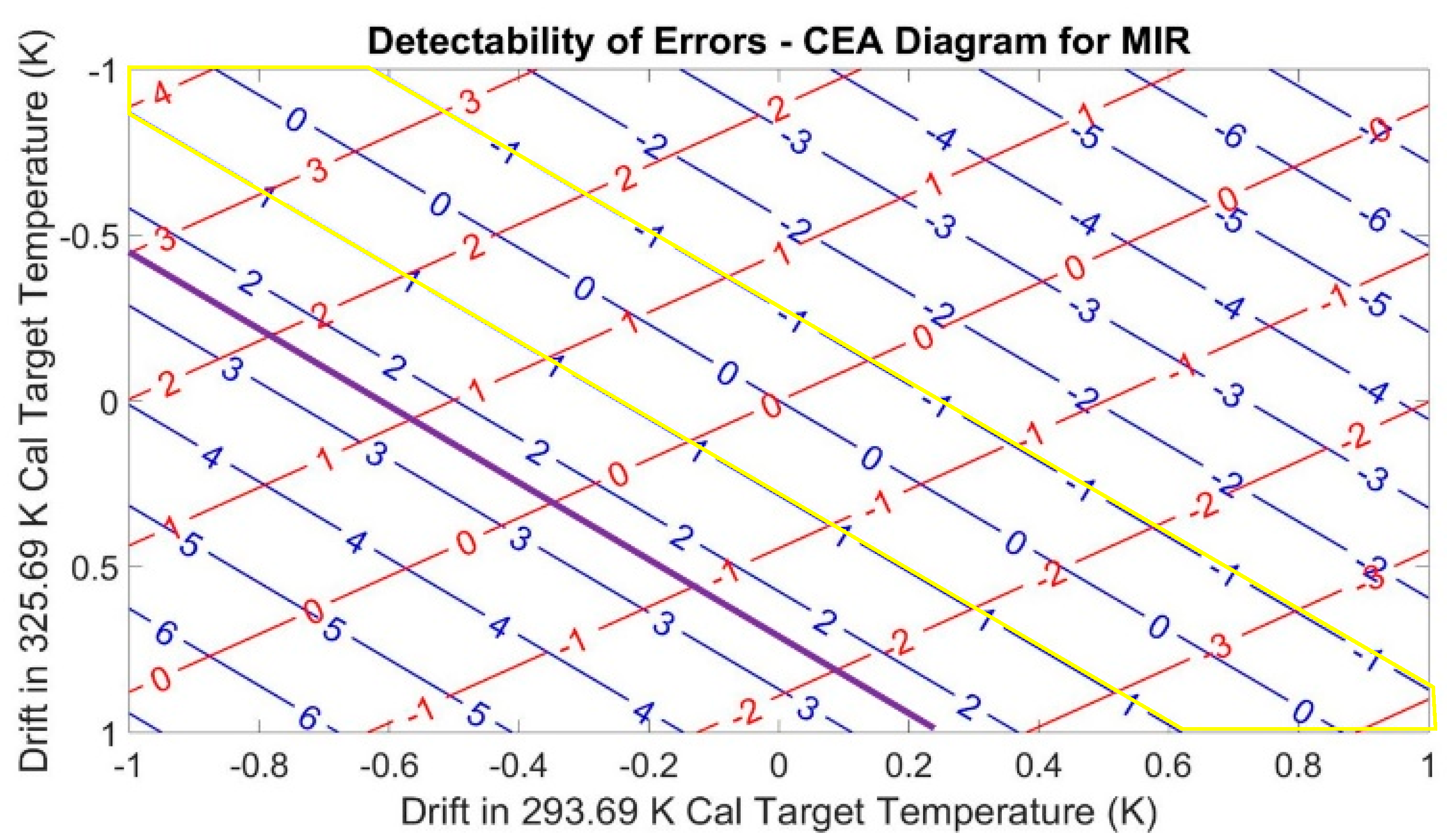
| Symbol | Parameter |
|---|---|
| Number of external calibration targets | |
| Temperature of the measurand | |
| Estimate of the measurand temperature as the result of calibration | |
| Temperature of the ith calibration target | |
| Mean temperature of the ith calibration target | |
| Post-gain voltage associated with the measurand observation | |
| Post-gain voltage associated with the ith calibration target observation | |
| Average temperature of the n calibration targets | |
| Average of the mean temperatures of the n calibration references | |
| Average of the voltage counts associated with n calibration targets | |
| Uncertainty associated with the measurand temperature estimate | |
| Radiometric resolution for the measurand observation | |
| Radiometric resolution for the ith calibration target | |
| Uncertainty associated with the mean temperature of the ith calibration target | |
| Radiometer receiver temperature | |
| Radiometer receiver bandwidth | |
| Radiometer integration time | |
| Radiometer gain | |
| Radiometer offset |
© 2019 by the authors. Licensee MDPI, Basel, Switzerland. This article is an open access article distributed under the terms and conditions of the Creative Commons Attribution (CC BY) license (http://creativecommons.org/licenses/by/4.0/).
Share and Cite
Aksoy, M.; Racette, P.E. A Preliminary Study of Three-Point Onboard External Calibration for Tracking Radiometric Stability and Accuracy. Remote Sens. 2019, 11, 2790. https://doi.org/10.3390/rs11232790
Aksoy M, Racette PE. A Preliminary Study of Three-Point Onboard External Calibration for Tracking Radiometric Stability and Accuracy. Remote Sensing. 2019; 11(23):2790. https://doi.org/10.3390/rs11232790
Chicago/Turabian StyleAksoy, Mustafa, and Paul E. Racette. 2019. "A Preliminary Study of Three-Point Onboard External Calibration for Tracking Radiometric Stability and Accuracy" Remote Sensing 11, no. 23: 2790. https://doi.org/10.3390/rs11232790






